
The common hornet (Vespa crabro in Latin) is one of the most common species of the Hornets. The appearance of this insect is well recognizable, and its size does not allow it to be confused with wasps or bees. This species is most common in our country, and in the whole world, among the 22 species of its relatives, the common hornet has the widest habitat: it inhabits the entire temperate zone of Eurasia and North America.
Ordinary or European hornet is almost the most frequent guest in the garden and suburban areas. Here he can settle, arranging his nests, or simply fly into the nearest landings and forests in search of food.
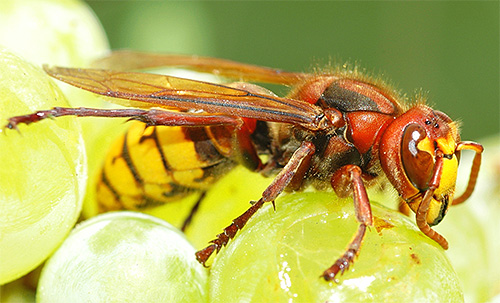
It is believed that the bite of an ordinary hornet is not only very dangerous for human health, but is also more painful compared to bites of wasps or bees.In general, it is difficult to argue with this statement, but for the most part, hornets are no more dangerous for people working on the site than other stinging insects. If you take a closer look at an ordinary hornet, this seemingly dubious fact will become obvious.
The appearance and anatomy of our largest wasp
If you look at an ordinary hornet from a systematic point of view, it becomes clear why this insect is so often compared to wasps, bees, ants and bumblebees: they are all related species, because enters the order Hymenoptera. And the European hornet looks like a greatly enlarged paper wasp, except that the top of his chest is repainted from black to brown.
In the photo below - ordinary hornet:
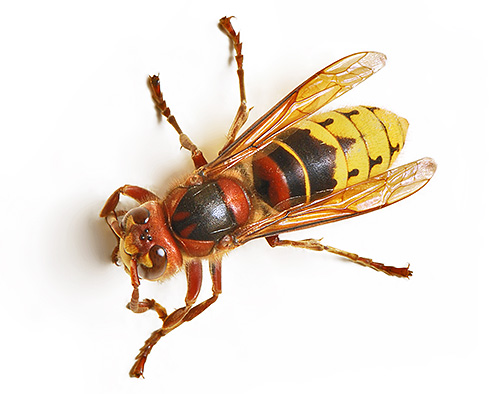
Experts know that hornets differ from os by some other details of coloring. For example, black constriction on the abdomen is less pronounced, and its very base is brown. However, from a distance, ordinary people can easily take hornets for the wasps themselves, especially if you see them in large numbers near the nest.
Photo of wasp:
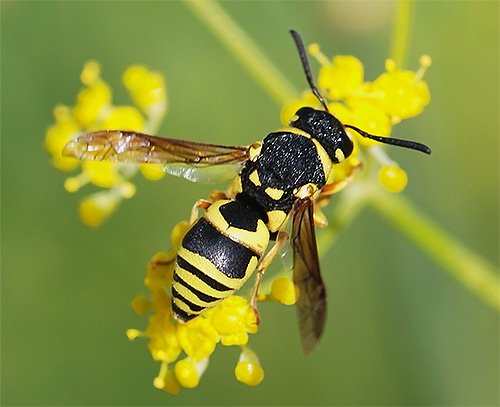
And below on photo - hornet ordinary:
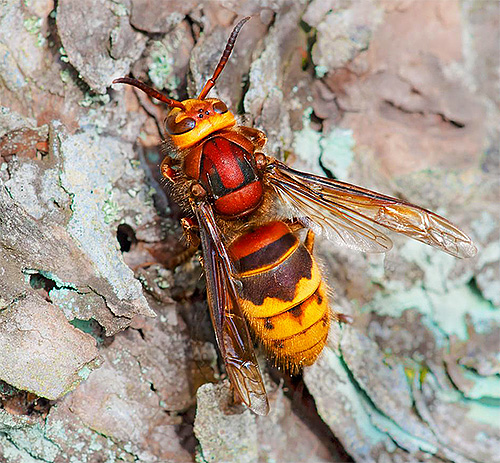
What, then, is the brightest, most pronounced difference between the hornets and the majority of its relatives? Of course, this is the size of the insect. The working individual of the common hornet reaches a length of 20-25 mm, and the uterus up to 35 mm. Due to its size, this insect is considered to be the largest wasp in Europe.
Here are some more photos of the common hornet:
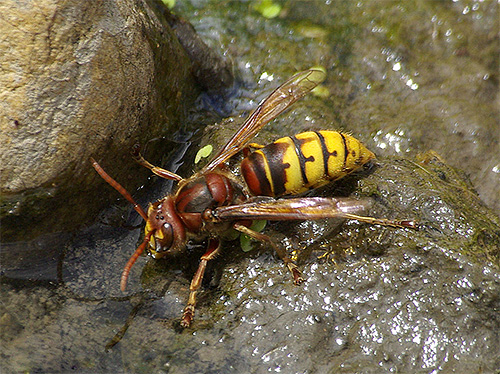

On a note
For scientist entomologists, the more accurate hallmark of hornets is the shape of their head: its back (occipital) part is much wider than the front. For this characteristic, specialists can easily distinguish the hornet from other large wasps found in some countries.
Within the family, the hornet of the common uterus from the working individuals can be distinguished primarily in size. However, in a more detailed study one can find some other differences between the inhabitants of the nest. So, for example, the abdomen of males, which, by the way, are only bred at the end of summer, is divided into 7 segments, while in females - by only six.
Another important feature of hornets is that their males do not have a stinger.
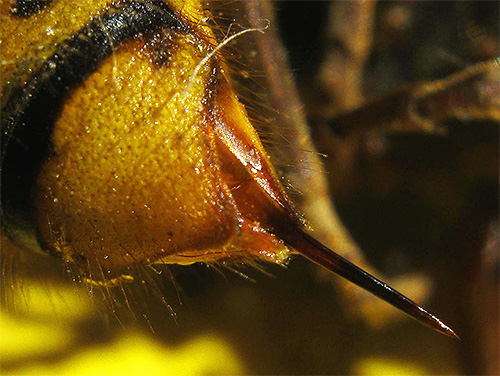
Nevertheless, it is extremely difficult to distinguish a male from a female with the naked eye straight off,therefore, in any case, in the presence of the hornet, some caution should be exercised.
Feedback
“Hornets were wound up in our dacha last year. They made a nest in the old shed under the roof, and no one noticed it until the wasps were bitten by the grandson. He came running all in tears, swollen, screaming: somewhere three or four hornets had bitten him, he immediately decided that it was a wasp. The husband went to look, it turned out - hornets. Well, we didn’t need this barn at all, we just closed it and left it so, this year the hornets didn’t return there. And at the small, all the rest in the village was spoiled - he had only a day on the eighth swelling on his cheeks began to subside.
Irina Gennadievna, Tver
How dangerous is the hornet?
How dangerous is the hornet for man? This topic is very popular among people, but the risk of meeting with this insect is still greatly exaggerated.
The poison of the hornet is really dangerous - it is a fact to dispute that there is no point. If we talk about the ratio of the number of complications after bites to the total number of registered attacks, then the common hornet takes the lead over wasps and bees.
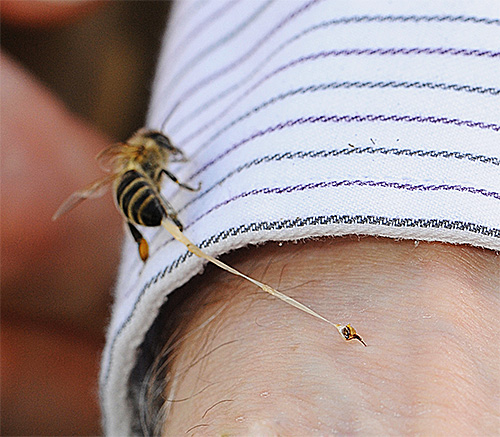
The poison of the hornet has a strong allergenic effect. It consists of histamine and some toxins that contribute to the additional release of this substance from the cells of the affected tissue. The main function of histamine is the acceleration of any allergic reaction, so even without a high sensitivity of the body to other components of the poison, it causes a powerful immune response.
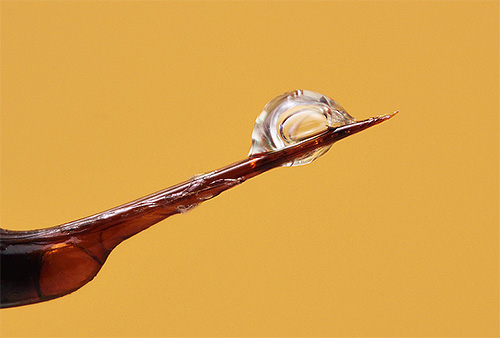
The degree of response of the human immune system to the poison of the hornet is purely individual. For some people who have been stung, allergies are manifested only by edema, for others, pain in the head, fever and palpitations are added to the edema. In some cases, especially when the body is highly sensitive to insect venom, anaphylactic shock and death can be the answer to the bite.
For the sake of truth, it is worth noting that in the entire history of world observations in our country there were only a few deaths that resulted from the bites of an ordinary hornet. Most often, people die from the "hands" giant hornets in Southeast Asia.
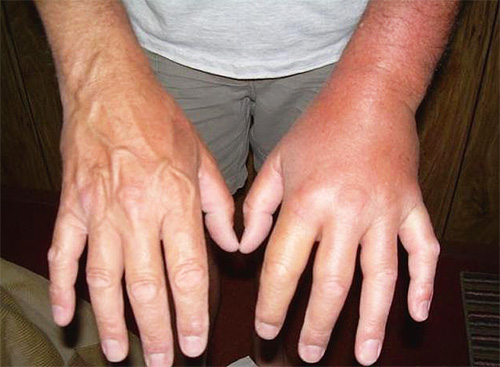
The poison of the hornets can cause heart palpitations due to the presence of stimulating components. Additionally, the poison contains a large amount of acetylcholine,causing severe irritation of the nerve endings and as a result - a sharp pain at the site of the bite.
It is interesting
The length of the sting of an ordinary hornet is about 3 mm. Unlike the bee, the hornet can use it many times. After a single bite, a sufficient amount of poison is preserved in the insect’s arsenal, which, moreover, is gradually being replenished with a new one.
Photo of the sting of a hornet ordinary:
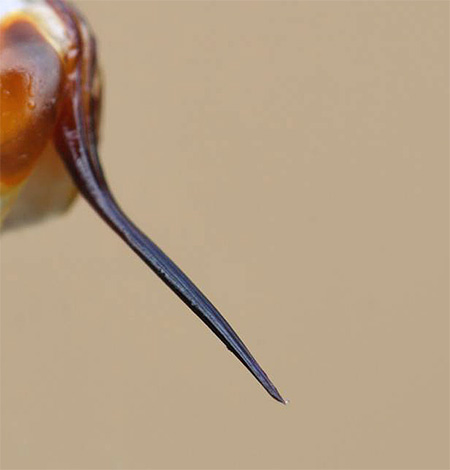
Treat the bite of an ordinary hornet, as something ordinary, will not work: after stinging, acute pain immediately appears, turning into severe throbbing. The soft tissues of the place where the hornet stung, quickly swell and become inflamed, and the person begins to feel heat and headaches. If the victim is prone to allergies, an increase in lymph nodes may occur, nausea, and sometimes Quincke’s edema may occur, leading to difficulty breathing.

However, despite the severity of the consequences of meeting the hornet, this insect as a whole can be characterized as:
- more rare in comparison with wasps and bees;
- much less aggressive;
- injecting into the enemy's wound a smaller dose of poison than the same bees.
These distinctive features of European hornets are noted not only by scientists-entomologists, but also by people who are far from science and are guided by their life experience. So, for example, gardeners collide on their plots with hornets about ten times less often than with wasps. If the hornets settle in close proximity to a person, then they are usually quite peaceful neighbors, not showing any aggression.

Even if it is persistent to "climb" into the life of an ordinary hornet, for example, to catch it specifically, the insect will try to fly away first, and will begin to sting only when it finds itself in the hands of the offender. Hornets will also attack if a person tries to reach and destroy their nest.
Experienced gardeners will confirm that even in cases of settling of hornets near the dacha toilet, insects do not react at all to people constantly scurrying in the immediate vicinity of their home. Therefore, arguing about the potential danger of an ordinary hornet, it is worth remembering - this insect will never attack first without good reason.
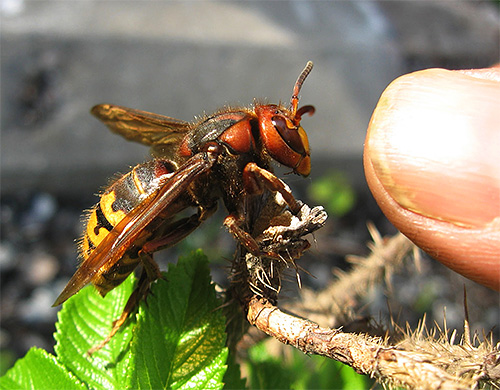
Another thing is if a person deliberately or unknowingly himself provokes a hornet to bite ...
Hornets as active predators
What eats the hornet ordinary? It is no secret that the basis of the diet of this active predator is made up of other insects, spiders, beetles, caterpillars, and various small arthropods. With the same hornets they feed their larvae, butchering their prey directly in the nest and handing selected soft pieces to the younger generation.
Sometimes hornets eat sweet berries and fruits, feed on the secretions of aphids, and when looting hives, the bees gladly enjoy the honey. However, only adult hornets can afford such gastronomic pleasures.
It is interesting
Hornets rarely use a sting to forage. As a rule, they kill prey with powerful jaws. Poison, however, is only put into action when the victim is too large and strong.
Hornets Against Bees they look like harsh killers - they are capable of causing serious damage to apiaries, exterminating honey-bearing insects with whole hives.

These predators track down bees carrying pollen to their home, mark the path to the hive, and then bring the whole family to it. A few dozen hornets are capable of completely destroying a large bee family in 4-5 hours, which has nothing to defend themselves with - the bee venom doesn’t affect the hornets.
Lifestyle and reproduction
The unit of the population of the common hornet is the family. In early spring, the young uterus finds a place suitable for arranging the nest, builds several honeycombs and lays eggs in them, and then extracts feed for the first larvae and cares for them. When working hornets appear in the new family, all the trouble of caring for the brood falls on them, and the task of the uterus is reduced only to laying new eggs.
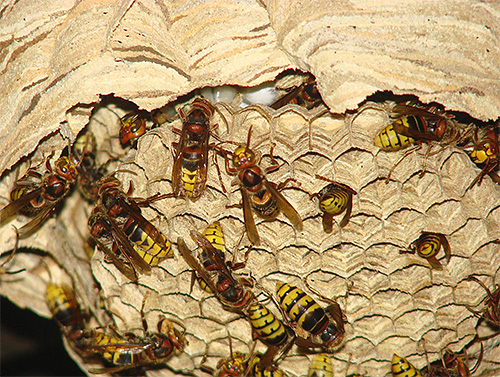
The life cycle of a single hornet is not so long: the development period from an egg to an adult insect is about 30 days, and the life span of an adult individual is up to 40 days.
The nest of ordinary hornets is a large one - up to 60 cm long and 40 cm wide - a structure made of fine wood bark, chewed by working hornets to a state of soft cardboard. It also builds honeycombs, which after hardening become a great place for the development of larvae.
On the picture - hornet's nest:

By the end of the summer, the family of common hornets becomes so large that it can provide food for individuals capable of breeding. The uterus begins to lay eggs, from which non-sterile females and males are derived. Around September and early October, these individuals swarm and mate.
A few weeks after mating, the males die, and the females look for suitable secluded places in the district (under stones, snags, in hollows) and hide in them for wintering so that in the summer each of them could give rise to a new family.
It is worth noting that the old uterus and working hornets perish in winter, and their nest is empty. However, young females never occupy the old nest - their new life always begins with a new home.
In nature, common hornets nests are most often located in hollows or on tree trunks.
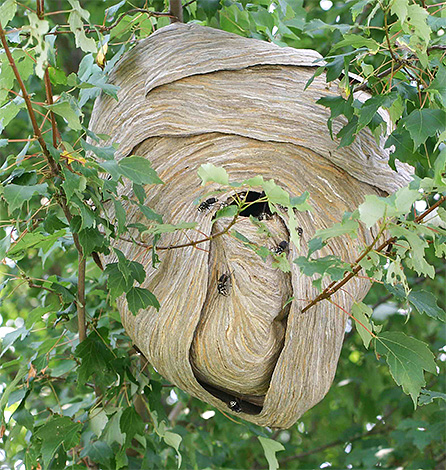
In the neighborhood of a person, for example, in summer cottages, these insects choose yard buildings, attics, niches under roofs and ramps, i.e. places where it is always calm and quiet.
Speaking about the neighborhood of the hornet and man, one cannot but pay attention to the craze for the fight with hornets, which has been taking place recently. As a result of such thoughtless extermination in many areas of our country, these insects began to occur extremely rarely, and therefore they began to be entered into the regional Red Books.
If an ordinary hornet settles on your personal plot, it is worthwhile to destroy its nest only when the insect's dwelling place constantly has to be disturbed during work.In this case, it is better not to risk and remove the nest in any safe way. If the dwelling place of insects is in a secluded place, they themselves are unlikely to bite the people living next to them for no reason.

Before you deal with hornets, be sure to remember that one of their family destroys up to 100 insect pests on your site per day. Before you kill a hornet just like that, think about how much support it can give you in the fight for the harvest.
When hornets attack a man and how to protect against it
Interesting video: we cut the hornets nest in the attic




I was stung by a hornet in the head
I was bitten by a hornet in my hand. Run ran to the hospital. And that, immediately put the drip and in the evening home went under its own power. Allergies to bees and wasps were not.
Hornets are flying in our village (Kardonovka), but not the same ones described here. They are 3-5 centimeters, not 30 mm!
Only here you have no schools in the village and no brains in your head. 30 mm - is this, in your opinion, not 3 cm?
And there is no 5-centimeter hornets, otherwise your village would already know the whole world and there, finally, they would build a school))
Up to 55 mm.
Dear, in 1 cm 10 mm, count the length of their hornets.
Learn materiel. 3 cm - this is 30 mm.
Timur, 30 mm - this is 3 cm))
The hornet stung in the nose.For three days I could not wear glasses, for two days half of my face was swollen.
Two years ago, my parents died a neighbor from the bites of hornets ((
In our village, one man died from the bite of hornets; they did not have time to bring to the hospital. He climbed on a hayfield in an old hut, and they, apparently, nested there, so the nest and accidentally collapsed.
Vespa Mandarinia hornet just 5 cm has body size, the article is right there, read.
Bitten Hornet. Fainted, 3 days headache, nausea, leg swollen.
Sting in the foot, swollen, scabies.
The son was bitten by a big wasp, only later realized that it was a hornet.
I read the article now and think - I am lucky! The parents of the bees were kept, and every year in the autumn, hornets, very large, more than 3 cm, flew to visit us at home. They rescued them all the time, let them out of the house. Often caught in a jar, considered and then released. I have never been stung, although I would probably have died, since the bees are seriously allergic. But they are impressive animals!
And once a big wasp stung me in my hand! Only then I realized that this is a hornet. Three days itching and inflammation was!
Neighboring us one year. Behaved very decently towards us. But the pears in one tree were completely devoured. It was terrible to approach a tree. They ate and moved to figs. They love fermented fruits. It is terrible, of course, but it is also funny to watch a drunk beast.
The hornet bit there, it swelled, but it was big. My wife didn't get up from the bed)) Of course, I'm kidding 🙂
It is a pity that I did not bite you in the ass))
I live on the 11th floor, and the hornet flies to the balcony not for the first time. Scary to horror ...
I live in the village of the Irkutsk region, this morning my wife asked me to climb into the attic, where we store salting jars. I climbed up, turned around, a cloud of hornets above me, moved a little - and you had 4 bites. He barely escaped, but fell still, his leg hurt. Here I lie, the whole back is on fire. Thank God, there is no tumor.
Wow
I was not stung, but I often saw them near the window.The grandfather says that the folk remedy is urine.
We have hornets, apparently, on the roof of the nest of the pile. At night they arrive at the window, then they are burned on incandescent lamps. Very buzzing. The cat catches these unfortunate half-dead hornets, and I feel sorry for them, and very much afraid that they won't bite ...